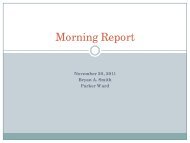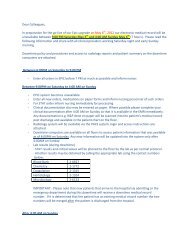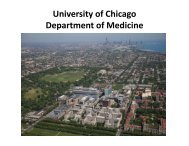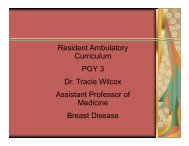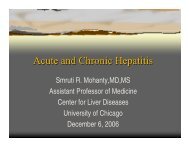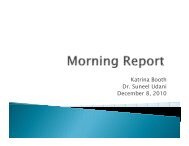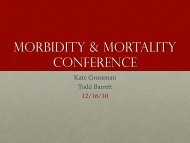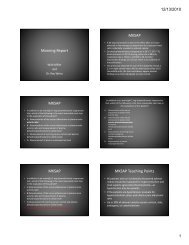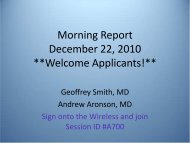Morning Report
Morning Report
Morning Report
You also want an ePaper? Increase the reach of your titles
YUMPU automatically turns print PDFs into web optimized ePapers that Google loves.
<strong>Morning</strong> <strong>Report</strong><br />
November 21 2011<br />
John Nick Gaetano<br />
Discussant: Dr. Rubin<br />
Please Swipe!
MKSAP<br />
A 29-year-old woman is evaluated for a 6-week<br />
history of bright red blood per rectum along with<br />
mucoid stool and tenesmus. She has two or three<br />
bowel movements a day. The patient is otherwise<br />
healthy and takes no medications; her parents and<br />
two siblings are alive and well.
MKSAP<br />
On physical examination, the temperature is 36.8<br />
°C (98.0 °F), the blood pressure is 110/76 mm Hg,<br />
the pulse rate is 76/min, and the respiration rate is<br />
12/min. There is no scleral icterus. The abdomen is<br />
soft and not tender or distended with normal bowel<br />
sounds. Rectal examination reveals red blood in the<br />
rectal vault with normal rectal tone and no palpable<br />
masses.
MKSAP<br />
Laboratory studies, including serum C-reactive<br />
protein and erythrocyte sedimentation rate, are<br />
normal. Ileocolonoscopy shows mild to moderate<br />
erythema from the anal verge to 10 cm; the rest of<br />
the colon and terminal ileum are normal. Biopsy<br />
specimens show mildly active chronic colitis in the<br />
rectum.
MKSAP<br />
Which of the following is the most appropriate<br />
therapy for this patient?<br />
A. Azathioprine<br />
B. Infliximab<br />
C. Mesalamine (topical)<br />
D. Metronidazole<br />
E. Prednisone
Please make your selection...<br />
A. Azathioprine<br />
B. Infliximab<br />
C. Mesalamine (topical)<br />
D. Metronidazole<br />
E. Prednisone<br />
20% 20% 20% 20% 20%<br />
A. B. C. D. E.
MKSAP<br />
Ulcerative colitis can be classified by both extent and<br />
severity of disease, and treatment is guided by both factors.<br />
This patient has mild to moderate ulcerative proctitis, with<br />
disease limited to the distal rectum. Therefore, the best<br />
treatment would be local therapy with suppositories or<br />
enemas. Options include cortisone foam and mesalamine<br />
or corticosteroid suppositories for proctitis and<br />
hydrocortisone or mesalamine enemas for left-sided colitis.<br />
Topical mesalamine is more effective than topical<br />
corticosteroids, and almost half of the dose of topical<br />
corticosteroids may be absorbed systemically, leading to<br />
adverse long-term side effects. Maintenance of remission<br />
can be achieved with topical mesalamine.
HPI<br />
36 M with a h/o AML s/p stem cell transplant 3 weeks ago<br />
presents to the ED with nausea, vomiting and diarrhea.
HPI<br />
36 M with a h/o AML s/p stem cell transplant 3 weeks ago<br />
presents to the ED with nausea, vomiting and diarrhea.<br />
• 10 day of chills, nausea/vomiting, no measured temp<br />
• Not keeping down food or liquids<br />
• 10 watery BM/day last 2 days, progressively worse over last<br />
week, small amount each episode, no blood, no distinct<br />
odor, no fecal incontinence, decreased with decreased PO<br />
• Cramping abd pain lasting ~20 sec, comes and goes,<br />
improved with BM<br />
• Burning substernally with food<br />
• No melena, no hematochezia, no hematemesis<br />
• No urinary sxs<br />
• No rash<br />
• <strong>Report</strong>s compliance with all meds
History<br />
PMHx<br />
• AML, flt-3+, dx 6 months<br />
ago. Induction Doxarubicin<br />
and Cytarabine, HIDAC<br />
consolidation 5 mo prior<br />
• Matched unrelated donor<br />
stem cell transplant 3<br />
weeks prior, d/c from<br />
hospital 2 days ago<br />
• VRE bacteremia/line<br />
infection during chemo<br />
Medications<br />
• tacrolimus 1mg q12<br />
• valacyclovir 2g q6<br />
• voriconazole 200mg bid<br />
• Bactrim ppx<br />
• Zofran prn<br />
• Vicodin<br />
Social Hx<br />
• Works for Airline, travels to<br />
China frequently, last time<br />
10 months ago.<br />
• No tobacco, no EtOH, no<br />
illicit drug use
Physical Exam<br />
Temp 36.5, HR 142, BP126/77, RR 18, PaO2 99% on RA<br />
Gen: lethargic, responds appropriately to questions, can give<br />
very precise history, oriented x3<br />
HEENT: Anicteric, Dry MM, No oral ulcers, no exudates, no<br />
erythema, no LAD.<br />
Cardiac: Tachy, regular, no murmurs/rubs, flat neck vein<br />
Lungs: CTAB<br />
Abd: Soft, non-tender, no distension, hyperactive BS, no<br />
organomegaly, no succusion, rectal exam deferred.<br />
Ext: warm and dry without erythema, without edema.<br />
Skin: no rashes, no purpura, no peticchiae<br />
Neuro: no deficits
Differential?
Acute Diarrhea - Differential<br />
Infectious (~90%) Non- Infectious<br />
Viral Infection<br />
• Rotavirus<br />
• Norwalk<br />
• Adenovirus<br />
• HSV<br />
• CMV<br />
Bacterial Infection<br />
• Shigella<br />
• Salmonella<br />
• Camplobacter<br />
• E. Coli<br />
• C. difficile<br />
• Staph Aureus<br />
• MAI<br />
Protozoa<br />
• Giardia<br />
• Cryptosporidium<br />
• Microsporidium<br />
Medications<br />
• Antibiotics<br />
• Antiarrhythmics<br />
• Anti-depressants<br />
• NSAIDS<br />
• Laxatives<br />
Ischemic Colitis<br />
Diverticulitis<br />
Ingestions / Withdrawal<br />
Graft Versus Host Disease<br />
Acute Episode / Presentation IBD
Diarrhea – an Acute Approach
Initial Labs?
Initial Labs<br />
8.1<br />
1.2 68<br />
76N 4L 14M ANC 920<br />
6.5 4.0<br />
0.3 0.3<br />
38 63<br />
284<br />
133<br />
3.2<br />
AG 12<br />
99<br />
22<br />
24<br />
1.0<br />
91<br />
INR 1.2<br />
UA normal, trace ketones<br />
8.7<br />
4.5<br />
1.4<br />
CXR unremarkable<br />
EKG sinus tach, otherwise nl
Management, further workup?<br />
Acute Diarrhea Work up*<br />
• If yes to any: Severe dehydration, duration > 5 days,<br />
mucus/pus/blood in BM, abd pain, recent travel, recent abx<br />
o Check fecal leuks, FOBT, C.diff<br />
• Neg fecal leuks, neg FOBT<br />
o Stool O&P x 3<br />
Pos O&P: parasitic infection<br />
Neg O&P: Med-induced (abx associated), viral,<br />
enterotoxic bacteria<br />
• Pos fecal leuks or pos FOBT<br />
o Stool Cx +/- colonscopy/flex sig<br />
Pos Cx: Cytoxic or invasive bacteria<br />
Neg Cx and positive endoscopic findings/bx: IBD,<br />
radiation, ischemia, GVHD<br />
• Pos C.diff: pseudomembranous colitis<br />
*Gastroenterology 1999; 116:1461-63
More labs, studies<br />
HR improves with IVF, now 70's<br />
EBV IgG 1:640, IgM
Diarrhea<br />
+ Abd pain, > 5 days<br />
• Neg fecal leuks, neg FOBT<br />
o Stool O&P x 3<br />
Pos O&P: parasitic infection<br />
Neg O&P: Med-induced (abx associated), viral,<br />
enterotoxic bacteria<br />
• Pos fecal leuks or pos FOBT<br />
o Stool Cx +/- colonscopy/flex sig<br />
Pos Cx: Cytoxic or invasive bacteria<br />
Neg Cx: correlate with endoscopic findings/bx: IBD,<br />
radiation, ischemia, GVHD<br />
• Pos C.diff: pseudomembranous colitis
More labs, studies<br />
Colonoscopy<br />
Terminal ileum appeared normal. A patchy area of mildly<br />
congested, erythematous and eroded mucosa was found from<br />
sigmoid to cecum. The rectum was involved with these<br />
changes, but less so.<br />
Impression: Non-specific colitis, but likely represented GVHD
Graft Versus Host Disease -<br />
Presentation<br />
• Acute GVHD defined as onset of sxs w/n 100 days of SCT<br />
• Classic presentation is abd cramps, diarrhea, rising bilirubin<br />
and maculopapular rash<br />
• Rash is most common initial sign, can range from sunburnt<br />
only on the neck to bullous lesions covering the entire body<br />
• Liver is the next most common site of involvement,<br />
manifesting as abnormal LFT's, with bili and alk phos rising<br />
first. Reflection of damage to bili canuliculi leading to<br />
cholestasis.
Graft Versus Host Disease -<br />
Presentation<br />
Intestinal manifestations<br />
• Cramping abd pain with diarrhea.<br />
• Severity determined by volume of diarrhea, which can<br />
exceed 10 liters per day<br />
• Frequently begins as watery diarrhea, can become bloody.<br />
Not unusual to require transfusions.<br />
• Ileus can become problematic if narcotic<br />
Upper GI manifestation<br />
• One study characterized GVHD in the upper GI as anorexia.<br />
dyspepsia, food intolerance, nausea and vomiting (biopsy+)<br />
• Upper GI sxs are more responsive to immunotherapy than<br />
lower GI sxs
Graft Versus Host Disease - Diagnosis<br />
• Can be made clinically if common presenting sxs are<br />
present<br />
• Histology is helpful if confirmation is needed<br />
o Typically, GVHD shows intracryptal apoptosis in 90% of<br />
biopsies. Most reliable indicator on path.<br />
• Biomarkers including IL-2, IL-8, TNF receptor-1 can aid in dx<br />
at the onset of sxs and provide prognostic information<br />
independent of severity<br />
• Graded 1-4, 1 being mild, and 4 being life threatening.<br />
Shidom et al. 2003 BMC Gastro enterol;3;5
Pathology
Hill GR, Ferrara JLM. The primacy of the gastrointestinal tract as a<br />
target organ of acute graft-versus-host disease: rationale for the use of<br />
cytokine shields in allogeneic bone marrow transplantation. Blood<br />
2000;95:2754–2759.
GVHD - Treatment<br />
• Steroids are used to treat acute clinical GVHD<br />
• T-cell Immunosuppressives<br />
o Cyclosporine - inhibits IL-2, renal toxicity<br />
o Tacrolimus inhibits IL-2, renal toxicity, neurotoxicity, target<br />
trough for GVHD is 10-30<br />
o Sirolimus - inhibits IL-2 transcription, more GI side effects<br />
than tacro<br />
o Mycophenolate - inhibits purine synthesis, key for T-cell<br />
activation, GI toxcity, marrow suppression, black box:<br />
progressive multifocal leukoencephalopathy.<br />
• Anti-thymocyte thyroglobulin<br />
• IVIg<br />
• Hydroxychloroquine - chronic GVHD, eye side effects<br />
• TNF-a inhibitors show 70% reduction of acute GVHD in<br />
animal models
Our patient<br />
Supportive treatment<br />
Steroid burst<br />
Diarrhea improved with steroids and therapeutic tacrolimus<br />
levels<br />
However...<br />
2 years later presents with persistent non-bloody, diarrhea for 2<br />
weeks, bloating and abdominal pain with bowel movements.
Our patient<br />
Supportive treatment<br />
Steroid burst<br />
Diarrhea improved with steroids and therapeutic tacrolimus levels<br />
However...<br />
2 years later presents with persistant non-bloody, diarrhea for 2 weeks,<br />
bloating and abdominal pain with bowel movements.<br />
Had been weaned from all medications 1 year prior. Last episode of<br />
neutropenia 1 year ago.<br />
Laboratory work-up unrevealing. No evidence of immunosuppression.
Repeat Colonoscopy<br />
Diffuse moderately erythematous, eroded and vascular-pattern-<br />
decreased mucosa was found from rectum to cecum.<br />
Biopsies:<br />
Terminal ileum - Mod active chronic ileitis, will ill-formed<br />
intramucosal granulomas<br />
R Colon, L Colon - Mod active colitis with epithelioid<br />
granulomas<br />
Recto-sigmoid - Mild to mod active colitis<br />
Comment: Findings likely represent inflammatory bowel dz<br />
(favor Crohn's), although a prolonged infectious enterocolitis<br />
should be ruled out.
Crohn's colitis after stem cell transplant<br />
vs. chronic GVHD?<br />
Auto-immune diseases have potential to be treated with SCT,<br />
but is the stem cell transplanted population at greater risk of<br />
acquiring auto-immune disease?<br />
• Late complications well-documented, although acquisition<br />
of auto-immune disease not among them.<br />
• Chronic GVHD is common, reported incidence between 40-<br />
70%*<br />
• Among patients with small bowel and colonic disease,<br />
chronic diarrhea, malabsorption, fibrosis of the submucosa,<br />
and sclerosis of the intestine may be observed.<br />
• Unclear if granuloma formation without overt apoptosis<br />
could be seen with chronic GVHD. Not typical.<br />
*Blood. 2010 Oct 28;116(17):3129-39
Crohn's colitis after stem cell transplant<br />
vs. chronic GVHD?<br />
Our patient responded well to mesalamine. Patient was no<br />
longer on tacrolimus or any other medication.<br />
All symptoms completely resolved within a week of starting<br />
treatment.<br />
Seen 7 months after starting treatment. Had 2 episodes of<br />
diarrhea, cramping and bloating, occurred two days after<br />
running out of mesalamine each time, and resolved<br />
completely upon restarting.
Crohn's colitis after stem cell transplant<br />
vs. chronic GVHD?<br />
Patient received non-myeloablative allogenic stem cell<br />
transplantation for Hodgkin’s<br />
Developed colitis, no infectious cause identified, pathology<br />
consistent with Crohn’s<br />
Responded to hydrocortisone and mesalazine<br />
Donor had NOD2/CARD15 polymorphism
Take Home Points<br />
• Understand the differential in diarrhea in the<br />
immunocompromised<br />
• Tailor your work-up of acute diarrhea based on symptoms<br />
and clinical signs.<br />
• Recognize the signs and symptoms of GVHD<br />
• Understand the pathogenesis of GVHD and the associated<br />
treatments
Chronic Diarrhea - Differential<br />
Inflammatory (fever, hematochezia,<br />
abd pain)<br />
• Infectious<br />
• IBD<br />
• Radiation enteritis<br />
• Ischemic colitis<br />
• GVHD<br />
Osmotic (decrease w fasting)<br />
• stool osm gap > 50<br />
• Medications (antacids, lactulose,<br />
sorbitol + many more)<br />
• Antibiotic associated (decrease<br />
fermentation of CHO to organic<br />
acids by normal flora, net decrease<br />
H20 absorption)<br />
• Lactose intolerance<br />
Secretory (no change with fasting, normal<br />
stool osm gap)<br />
• Hormonal (neuroendocrine tumors,<br />
thyroid dx, Addison's, hyperPTH, DM)<br />
• Laxative abuse/stimulants<br />
• Colitis (diverticulitis, collagenous, IBD)<br />
Malassimalation (inc. fecal fat, gap>50)<br />
• celiac, tropical sprue<br />
• whipple's dz<br />
• panc insufficiency<br />
• Bacterial overgrowth<br />
• Short bowel syndrome<br />
Motility/Functional<br />
• IBS<br />
• Rheumatologic (scleraderma)



